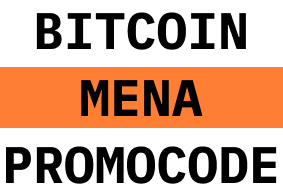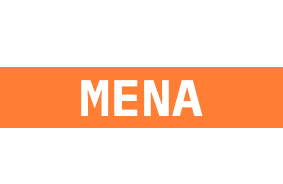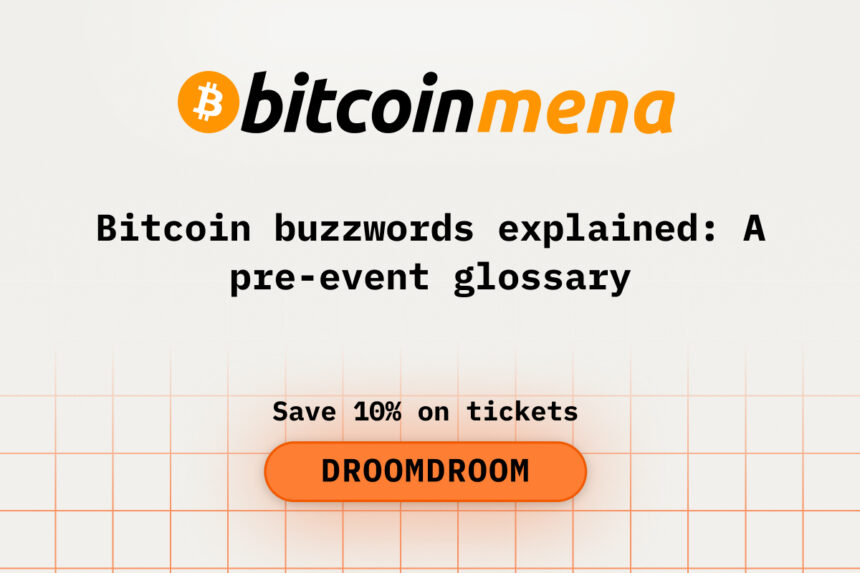As Bitcoin MENA approaches in Abu Dhabi, attendees will be immersed in conversations laden with acronyms, slang, and technical terms. For first timers or even seasoned participants, keeping up can be daunting. This glossary decodes key buzzwords you’re likely to hear across panels, interviews, booth demos, and tweet threads. Knowing these in advance will help you follow along, ask sharper questions, and report insights more confidently. And if you haven’t got your ticket yet:
Book Bitcoin MENA at 10% off by entering the official promo code DROOMDROOM.
Fundamental Bitcoin & Protocol Terms
Block / Blockchain
A block is a batch of validated transactions. Multiple blocks, when linked sequentially, form the blockchain, which acts as an immutable ledger of all Bitcoin activity.
BTC & Satoshi
BTC is the standard ticker for one whole bitcoin. A satoshi (sat) is the smallest unit — there are 100 million sats in one BTC.
Hashrate & Difficulty
Hashrate measures the total computational power used by miners. Difficulty is an algorithmic adjustment that ensures blocks continue to appear roughly every 10 minutes, regardless of how much hashing power is added or subtracted.
Mining & Proof of Work
Mining is the process of validating transactions and adding them to the blockchain. Proof of Work (PoW) is the method by which miners must perform computational labor to create blocks—this underpins Bitcoin’s security model.
Node & Consensus
A node is a computer running the Bitcoin software, validating and relaying transactions. Consensus refers to the alignment among nodes regarding which blocks are valid and which chain is the real one.
UTXO (Unspent Transaction Output)
Bitcoin uses a UTXO accounting model. When you receive BTC, it becomes an output that is “unspent” until you later use it in a transaction.
Market & Culture Slang
HODL
Once a typo, now a battle cry meaning “Hold On (for) Dear Life” — stand firm through volatility instead of selling in panic.
FOMO / FUD
FOMO is the Fear Of Missing Out, pushing late entry. FUD stands for Fear, Uncertainty & Doubt — often the negative narratives that shake sentiment.
Moon / To the Moon
Used when predicting a massive upward price move. “Moon” implies price skyrocketing far beyond current levels.
Rekt
Short for “wrecked”—meaning significant loss, often from overleveraging or bad timing.
ATH / ATL
ATH = All-Time High.
ATL = All-Time Low.
Whale
An entity or individual holding a huge volume of bitcoin. Their trades can move the market noticeably.
Bagholder
Someone stuck holding BTC after its value has dropped significantly, often unable to exit without loss.
Upgrades, Scalability & Governance
Soft Fork / Hard Fork
A soft fork is a backward-compatible network change; old nodes can often still validate. A hard fork is a non-backward-compatible change requiring all nodes to upgrade, possibly splitting chains.
Layer 1 / Layer 2
Layer 1 is the base Bitcoin protocol itself. Layer 2 solutions, like the Lightning Network, sit atop base layer to enhance scalability, lower fees, and enable faster off-chain transfers.
SegWit, Taproot & Schnorr
Segregated Witness (SegWit) reorganized how signatures are recorded to save block space. Taproot and Schnorr further extend privacy, multisig flexibility, and script efficiency.
Mempool
The mempool is the waiting area for unconfirmed transactions. Miners pull from this pool to create new blocks.
CoinJoin / Privacy Tools
CoinJoin is a method to mix multiple users’ transactions to obscure tracing. Various privacy tools and protocols aim to enhance transaction anonymity.
Purchase your Bitcoin MENA ticket now and save 10% with the official promo code DROOMDROOM.
Ecosystem, Token & DeFi Terms
Tokenomics
This term describes how a token’s economic model works: total supply, issuance rate, utility, incentives, staking, deflation/inflation mechanics.
Liquidity Mining / Yield Farming
Providing liquidity to exchange pools in return for rewards. It’s a core mechanism in many decentralized finance (DeFi) models.
DAO
A Decentralized Autonomous Organization, where decisions are made via protocol and community voting backed by token holdings.
Rug Pull
A scam where developers abandon a project and withdraw liquidity, leaving investors unable to exit.
Pump & Dump / Shill
Pump & dump: hype-driven price surge followed by selloff. Shill: promotional behavior often oriented to inflate interest artificially.
Using This Glossary at Bitcoin MENA
As panels and keynotes unfold, these terms will surface repeatedly. When you hear terms like Taproot, UTXO, whale, or DAO, having their meaning ready helps you parse discussions and engage intellectually. If you’re live tweeting or creating recap threads, using these buzzwords helps your audience—and search traffic—connect to real conversations.
In your post-event articles or videos, you’ll likely pepper in these terms to signal subject matter expertise. For example, writing “the Taproot upgrade unlocked new privacy composability” or “mining hashrate and difficulty adjustments remain central topics” boosts relevance for readers who search those words.
And as you network, dropping buzzwords naturally (but not excessively) signals you understand the field—making conversations smoother. “I was interested in the mempool backlog discussion during the panel” sounds better than describing the concept awkwardly from scratch.
Enjoy 10% savings on Bitcoin MENA tickets by applying the official promo code DROOMDROOM.
Conclusion
This pre-event glossary gives you a head start at Bitcoin MENA. While the ecosystem continues evolving, mastering the fundamentals above sets you up to engage meaningfully, ask sharper

















